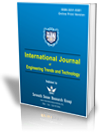Designing and Evaluating Circular and Square Coils for Tissue Monitoring using RF Wireless Power Transmission
Designing and Evaluating Circular and Square Coils for Tissue Monitoring using RF Wireless Power Transmission |
||
 |
 |
|
| © 2024 by IJETT Journal | ||
| Volume-72 Issue-12 |
||
| Year of Publication : 2024 | ||
| Author : Saad Mutashar, Mokhalad Alghrairi |
||
| DOI : 10.14445/22315381/IJETT-V72I12P120 | ||
How to Cite?
Saad Mutashar, Mokhalad Alghrairi, "Designing and Evaluating Circular and Square Coils for Tissue Monitoring using RF Wireless Power Transmission," International Journal of Engineering Trends and Technology, vol. 72, no. 12, pp. 227-234, 2024. Crossref, https://doi.org/10.14445/22315381/IJETT-V72I12P120
Abstract
Tissue engineering, a burgeoning multidisciplinary field, seeks to repair or replace damaged tissues and organs by leveraging engineering and biological principles. Central to the advancement of this field is the ability to monitor tissue growth in real-time. This necessitates the use of implantable devices, such as sensors, which need to be powered. Traditional power sources, like batteries, could impede tissue growth and tissue damage, making Wireless Power Transfer (WPT) an attractive alternative. This study delves into detail the design and evaluation of coil configurations for RF wireless power transmission applied to tissue monitoring. Specifically, the contrast of the performance metrics between two coil designs: one featuring four circular coils and another blending three square coils with one circular coil. The analyses revealed that while both configurations experience diminished performance as the distance between transmitter and receiver increases, the efficiency for four circular coils at a distance of 30 mm is 25%, and for three square coils and one circular coil is 45%, and their efficiencies vary distinctly. Circular coils showcased higher power transfer efficiency and biocompatibility, whereas a combination of square and circular coils extended the transmission distance. Our findings illuminate the interplay between coil design and WPT performance, offering invaluable insights for developing implantable devices tailored for real-time tissue growth monitoring. This study propels the design endeavors in WPT and positions itself as a pivotal reference for applications in wound healing, organ transplantation, and drug testing.
Keywords
Tissue engineering, Wireless Power Transmission, Coil design, Implantable devices, Circular coils, Square coils.
References
[1] Janine N. Post et al., “Implementing Computational Modeling in Tissue Engineering: Where Disciplines Meet,” Tissue Engineering Part A, vol. 28, no. 11-12, pp. 542-554, 2022.
[CrossRef] [Google Scholar] [Publisher Link]
[2] Joseph P. Vacanti, and Robert Langer, “Tissue Engineering: The Design and Fabrication of Living Replacement Devices for Surgical Reconstruction and Transplantation,” The lancet, vol. 354, pp. S32-S34, 1999.
[Google Scholar] [Publisher Link]
[3] Zeming Gu et al., “Development Of 3D Bioprinting: From Printing Methods to Biomedical Applications,” Asian Journal of Pharmaceutical Sciences, vol. 15, no. 5, pp. 529-557, 2020.
[CrossRef] [Google Scholar] [Publisher Link]
[4] Justine R. Yu et al., “Current and Future Perspectives on Skin Tissue Engineering: Key Features of Biomedical Research, Translational Assessment, and Clinical Application,” Advanced Healthcare Materials, vol. 8, no. 5, 2019.
[CrossRef] [Google Scholar] [Publisher Link]
[5] Maurice N. Collins et al., “Scaffold Fabrication Technologies and Structure/Function Properties in Bone Tissue Engineering,” Advanced Functional Materials, vol. 31, no. 21, 2021.
[CrossRef] [Google Scholar] [Publisher Link]
[6] Kang Kim, and William R. Wagner, “Non-Invasive and Non-Destructive Characterization of Tissue Engineered Constructs Using Ultrasound Imaging Technologies: A Review,” Annals of Biomedical Engineering, vol. 44, pp. 621-635, 2016.
[CrossRef] [Google Scholar] [Publisher Link]
[7] Saumya Prasad et al., “Optical and Magnetic Resonance Imaging Approaches for Investigating the Tumour Microenvironment: State-Of-The-Art Review and Future Trends,” Nanotechnology, vol. 32, no. 6, 2020.
[CrossRef] [Google Scholar] [Publisher Link]
[8] Yoshiharu Ohno et al., “Magnetic Resonance Imaging (MRI) and Positron Emission Tomography (PET)/MRI for Lung Cancer Staging,” Journal of Thoracic Imaging, vol. 31, no. 4, pp. 215-227, 2016.
[CrossRef] [Google Scholar] [Publisher Link]
[9] Fatima T Alrashdan et al, “Wearable Wireless Power Systems for ‘ME-BIT’magnetoelectric-Powered Bio Implants,” Journal of Neural Engineering, vol. 18, no. 4, 2021.
[CrossRef] [Google Scholar] [Publisher Link]
[10] Jungang Zhang et al., “Battery‐Free and Wireless Technologies for Cardiovascular Implantable Medical Devices,” Advanced Materials Technologies, vol. 7, no. 6, 2022.
[CrossRef] [Google Scholar] [Publisher Link]
[11] Prasad Jayathurathnage, Yining Liu, and Jorma Kyyrä, “Self-Decoupled and Integrated Coils for Modular Multitransmitter Wireless Power Transfer Systems,” IEEE Transactions on Power Electronics, vol. 37, no. 11, pp. 12962-12967, 2022.
[CrossRef] [Google Scholar] [Publisher Link]
[12] Amjad Iqbal et al., “Wireless Power Transfer System for Deep-Implanted Biomedical Devices,” Scientific Reports, vol. 12, pp. 1-13, 2022.
[CrossRef] [Google Scholar] [Publisher Link]
[13] D. B. Ahire, Vitthal J. Gond, and Jayant J. Chopade, “Geometrical Parameter Optimization of Planner Square-Shaped Printed Spiral Coil for Efficient Wireless Power Transfer System to Biomedical Implant Application,” e-Prime-Advances in Electrical Engineering, Electronics and Energy, vol. 2, 2022.
[CrossRef] [Google Scholar] [Publisher Link]
[14] Mohamad Abou Houran, Xu Yang, and Wenjie Chen, “Magnetically Coupled Resonance WPT: Review of Compensation Topologies, Resonator Structures with Misalignment, and EMI Diagnostics,” Electronics, vol. 7, no. 11, pp. 1-45, 2018.
[CrossRef] [Google Scholar] [Publisher Link]
[15] Dong-Wook Seo, “Comparative Analysis of Two-And Three-Coil WPT Systems Based on Transmission Efficiency,” IEEE Access, vol. 7, pp. 151962-151970, 2019.
[CrossRef] [Google Scholar] [Publisher Link]
[16] Seok Hyon Kang et al., “Magnetic Resonant Three-Coil WPT System Between Off/In-Body for Remote Energy Harvest,” IEEE Microwave and Wireless Components Letters, vol. 26, no. 9, pp. 741-743, 2016.
[CrossRef] [Google Scholar] [Publisher Link]
[17] Paulo J. Abatti et al., “Analysis and Optimisation of Three-Coil Wireless Power Transfer Systems,” IET Power Electronics, vol. 11, no. 1, pp. 68-72, 2018.
[CrossRef] [Google Scholar] [Publisher Link]
[18] Ehsan Ashoori et al., “Design of Double Layer Printed Spiral Coils for Wirelessly-Powered Biomedical Implants,” Annual International Conference of the IEEE Engineering in Medicine and Biology Society, Boston, MA, USA, pp. 2882-2885, 2011.
[CrossRef] [Google Scholar] [Publisher Link]
[19] Xin Wang et al., “Design of Double-Layer Parallel Printed Spiral Coil for Wireless Power Transfer Applied to Rotating Equipment,” Sensors and Actuators A: Physical, vol. 331, 2021.
[CrossRef] [Google Scholar] [Publisher Link]
[20] Sadeque Reza Khan, and GoangSeog Choi, “Analysis and Optimization of Four-Coil Planar Magnetically Coupled Printed Spiral Resonators,” Sensors, vol. 16, no. 8, pp. 1-24, 2016.
[CrossRef] [Google Scholar] [Publisher Link]
[21] Amritansh Sagar et al., “A Comprehensive Review of The Recent Development of Wireless Power Transfer Technologies for Electric Vehicle Charging Systems,” IEEE Access, vol. 11, pp. 83703-83751, 2023.
[CrossRef] [Google Scholar] [Publisher Link]
[22] Zhen Zhang et al., “Wireless Power Transfer-An Overview,” IEEE Transactions on Industrial Electronics, vol. 66, no. 2, pp. 1044-1058, 2018.
[CrossRef] [Google Scholar] [Publisher Link]

